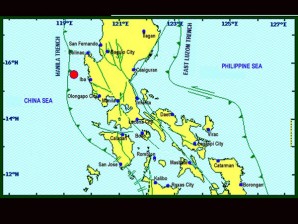Strong quake jolts Luzon
OLONGAPO CITY, Philippines—Masses were briefly disrupted and residents in central and northern Luzon were roused from sleep as a magnitude-6 earthquake hit Zambales on Sunday morning.
The US Geological Survey put its magnitude at 6.1, adding that it struck 182 kilometers northwest of Manila.
The epicenter of the quake, which jolted northwestern Luzon at 6:18 a.m., was located 52 kilometers southwest of Candelaria, Zambales, the Philippine Institute of Volcanology and Seismology (Phivolcs) reported.
Phivolcs chief Renato Solidum said it was most possibly caused by movement in the Manila Trench in the West Philippine Sea (South China Sea) off Zambales province.
Solidum said the quake was not strong enough to generate a tsunami alert.
Earlier, at 1:18 a.m., Baguio City was shaken by a magnitude-3.8 earthquake with an epicenter traced at 5 km northwest of La Trinidad, Benguet.
Central Luzon officials and the regional police did not report any damage to roads, bridges, irrigation dikes, houses and buildings in the region as of Sunday morning, Josefina Timoteo, director of the Office of Civil Defense in the region said, citing reports from disaster risk reduction and management councils.
Residents in coastal villages in Candelaria town, where the earthquake was felt at Intensity 4, did not panic when the earthquake struck, she said. The quake was also felt at Intensity 4 in Iba, Zambales.
Timoteo said Candelaria Mayor Jean Moraña described the quake as “quite strong.”
Graciela Macabare, head of the provincial disaster risk reduction and management council in Zambales, said no damage or injury was reported from the earthquake that lasted only about 30 seconds.
“It’s good that it didn’t last long. If it did, it might have caused damage,” Macabare said by telephone.
She said three aftershocks followed. These quakes, with magnitudes measuring between 3 and 3.3, struck at 6:37, 6:49 and 7:05 Sunday morning.
“We are continually monitoring the situation from the provincial capitol but so far, there are negative reports of damage or injury,” Macabare said.
She said the province’s disaster response team was activated when the quake struck. “We also called the mayor of Candelaria and checked their coastline. The (quake was strong), but the aftershocks lasted longer,” she said.
Catholic priests in central Luzon said early morning Masses were briefly disrupted as Mass goers noticed the ground shaking.
Arnel Suba, 40, a resident of Mabalacat, Pampanga, said his first reaction was for him and his wife to run outside their house. “But the earthquake stopped before we were able to go outside,” he said.
Coleen Cunanan, a high school student, also from Mabalacat, said the earthquake awakened her family.
“I thought I was dreaming but then I heard my parents saying that there was an earthquake. I got out of bed but it stopped after a while,” she said.
The quake was felt at Intensity 4 in Makati City; Intensity 3 in Quezon City; Intensity 2 in Bacoor, Cavite; and Intensity 1 in Tagaytay City. It also shook Manila, Pasay City and Pateros, according to a report by Radyo Inquirer 990AM.
In Pangasinan, the earthquake was felt at Intensity 4 in Dagupan City and the towns of Bolinao, Villasis and Bugallon; Intensity 3 in San Fernando City, La Union; and Intensity 2 in Plaridel, Bulacan; and Bacoor, Cavite; and Intensity 1 in Tagaytay City.
“Any earthquake felt in a very large area is tectonic,” Dr. Renato Solidum, Phivolcs chief, said, referring to the movement of the earth’s plates.
Sunday’s quake was the ninth that struck Zambales since January, Phivolcs records showed.
Intensity 4 means most people indoors could feel the shaking and hanging objects would sway and some objects in the house would rattle. The earthquake is strong enough to rock parked cars and some people might feel the movement outdoors.
Intensity 3 means many people indoors would feel the movement and hanging objects would be seen swaying. Intensity 2 means a few people would feel the shaking if they are indoors and on the upper floors of a building.
Intensity 1 means people hardly feel anything.
In 1990, a magnitude-7.7 quake killed nearly 2,000 people in the northern Luzon region.
The Philippines sits on the Pacific “Ring of Fire” where continental plates collide causing frequent seismic and volcanic activity.
For updates, listen to Radyo Inquirer 990AM.—Reports from Tonette Orejas, Robert Gonzaga and Jun Malig, Inquirer Central Luzon, and Gabriel Cardinoza, Inquirer Northern Luzon; Radyo Inquirer 990 AM; and Associated Press
Originally posted at 08:33 am| Sunday, June 17, 2012















